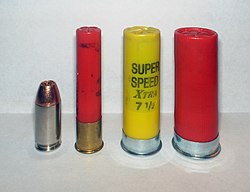Gauge (firearms)

The gauge (U.S. English) or bore (British English) is the inside width of the barrel of a firearm.
So, a 12-bore shotgun could take a cartridge with a solid sphere of lead which fits a 12-guage bore.[1] Actually, the gun fires a cartridge which looses off a cluster of small lead pellets. They in total weigh the same as the single lead sphere which just fits the barrel.
Lead is poisonous, and builds up in the environment. By 1919, the spent lead pellets from waterfowl hunting was identified as a major source of deaths of bottom-feeding waterfowl.[2][3][4] So the tendency is to switch to steel pellets in the cartridge. Dense (heavy) plastic pellets in cartridges is another option, standard in competition shooting.[5]
References[change | change source]
- ↑ Barnes, Frank C.; Woodard, W. Todd 2016. Cartridges of the world : a complete and illustrated reference for more than 1500 cartridges (15th ed). Krause Publications. p. 629. ISBN 1440246424.
- ↑ Federal Cartridge Company waterfowl and steel shot guide. Volume I; 1988.
- ↑ Sanderson, Glen C. and Frank C. Bellrose. 1986. A review of the problem of lead poisoning in waterfowl. Illinois Natural History Survey, Champaign, Illinois. Special Publication 4. 34pp. full report from scholar.google.com (cache)
- ↑ A.M. Scheuhammer and S L. Norris. 1996. The ecotoxicology of lead shot and lead fishing weights. Ecotoxicology 5 #5, p279-295
- ↑ Shotgun sports [1]
